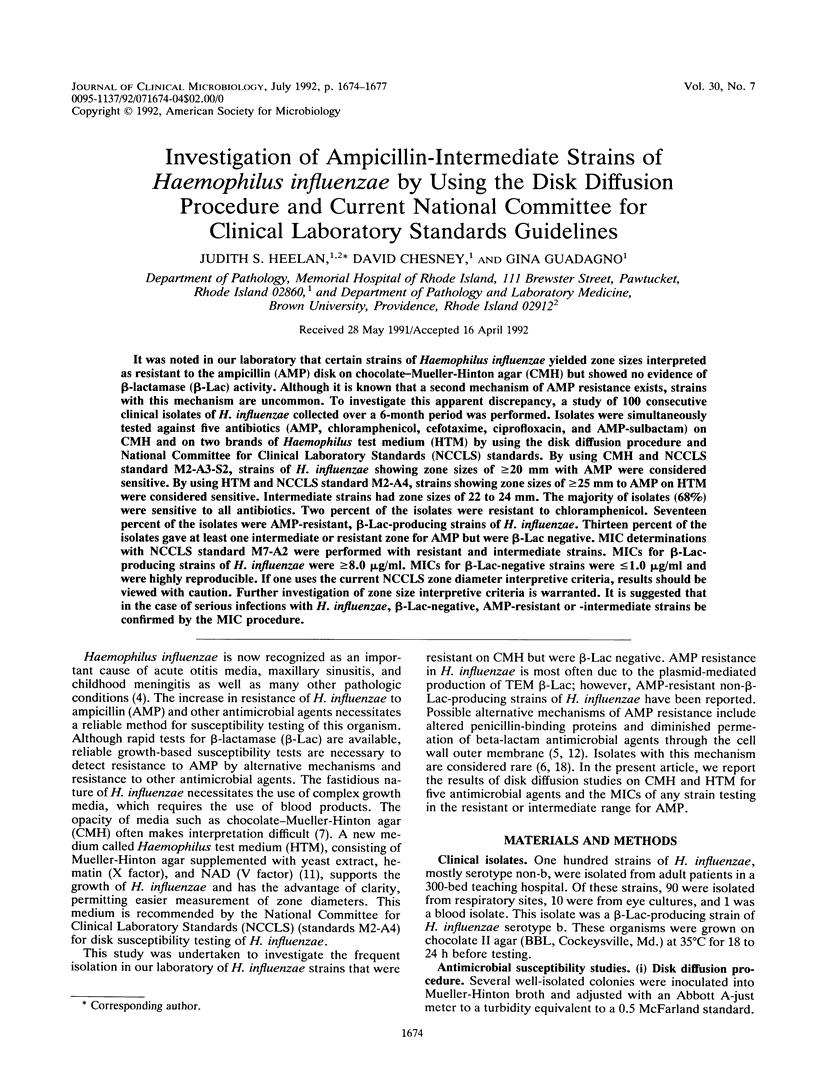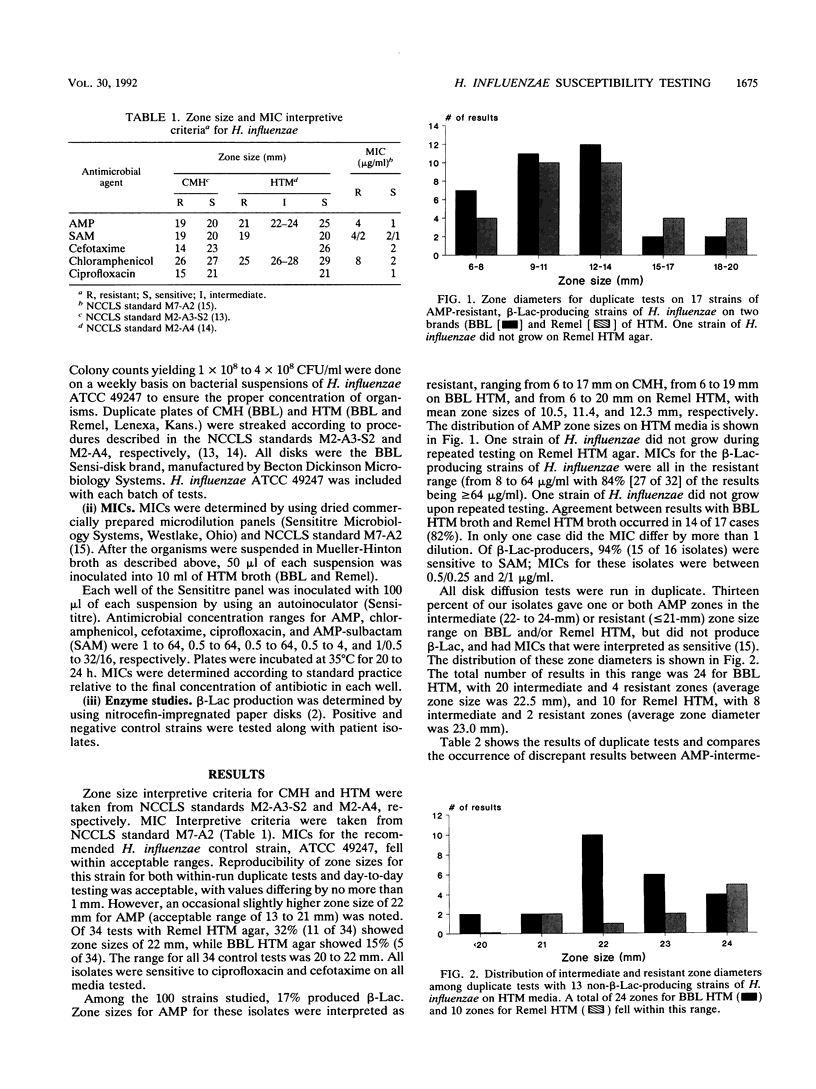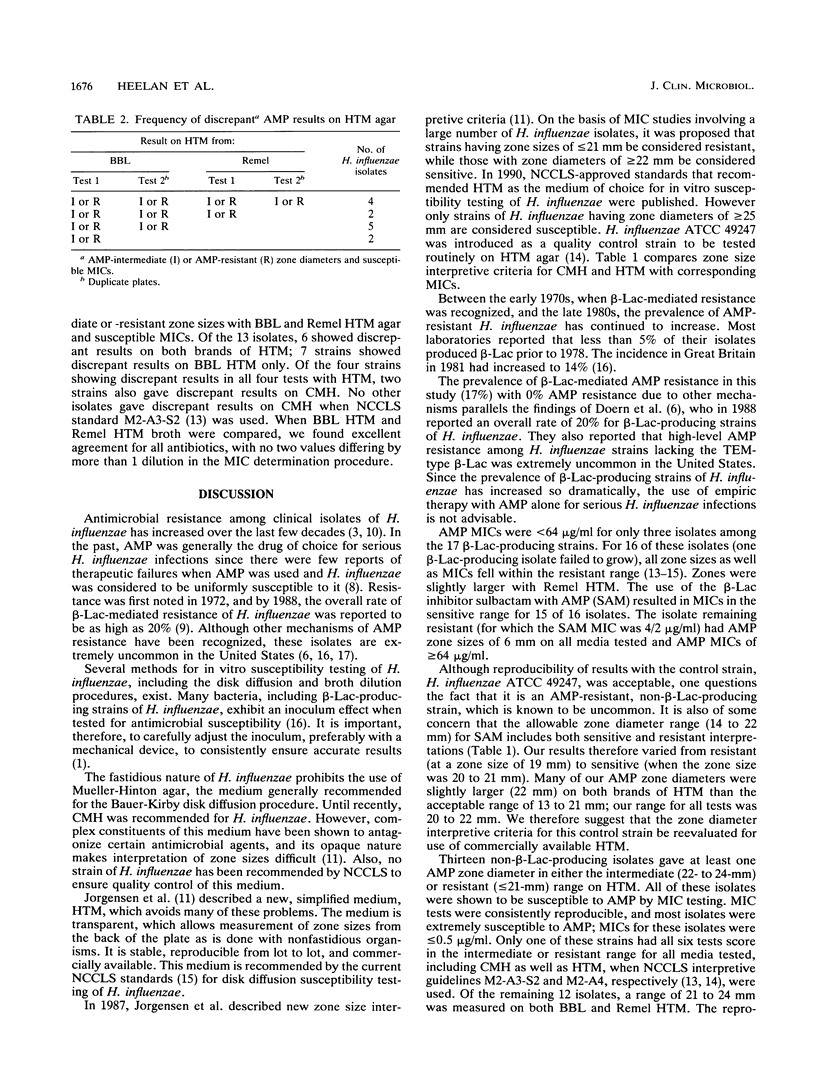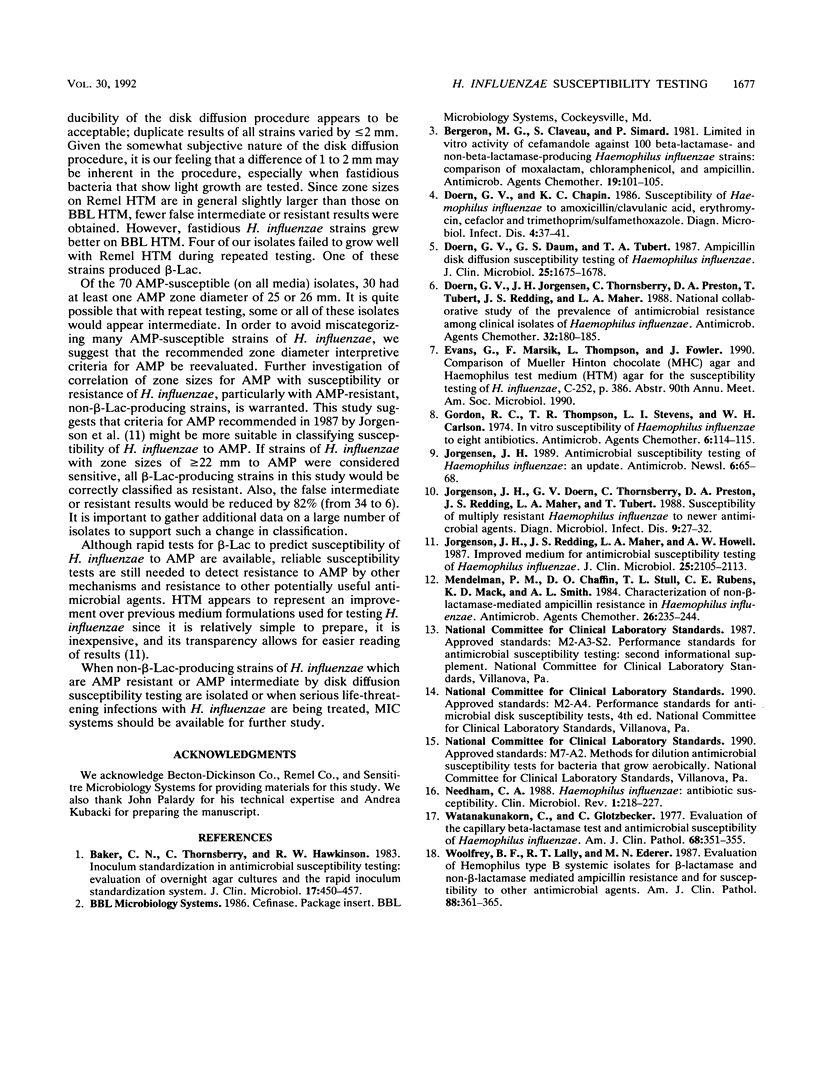Abstract
It was noted in our laboratory that certain strains of Haemophilus influenzae yielded zone sizes interpreted as resistant to the ampicillin (AMP) disk on chocolate-Mueller-Hinton agar (CMH) but showed no evidence of beta-lactamase (beta-Lac) activity. Although it is known that a second mechanism of AMP resistance exists, strains with this mechanism are uncommon. To investigate this apparent discrepancy, a study of 100 consecutive clinical isolates of H. influenzae collected over a 6-month period was performed. Isolates were simultaneously tested against five antibiotics (AMP, chloramphenicol, cefotaxime, ciprofloxacin, and AMP-sulbactam) on CMH and on two brands of Haemophilus test medium (HTM) by using the disk diffusion procedure and National Committee for Clinical Laboratory Standards (NCCLS) standards. By using CMH and NCCLS standard M2-A3-S2, strains of H. influenzae showing zone sizes of greater than or equal to 20 mm with AMP were considered sensitive. By using HTM and NCCLS standard M2-A4, strains showing zone sizes of greater than or equal to 25 mm to AMP on HTM were considered sensitive. Intermediate strains had zone sizes of 22 to 24 mm. The majority of isolates (68%) were sensitive to all antibiotics. Two percent of the isolates were resistant to chloramphenicol. Seventeen percent of the isolates were AMP-resistant, beta-Lac-producing strains of H. influenzae. Thirteen percent of the isolates gave at least one intermediate or resistant zone for AMP but were beta-Lac negative. MIC determinations with NCCLS standard M7-A2 were performed with resistant and intermediate strains. MICs for beta-Lac-producing strains of H. influenzae were >/= 8.0 microgram/ml. MICs for beta-Lac-negative strains were </= 1.0 microgram/ml and were highly reproducible. If one uses the current NCCLS zone diameter interpretive criteria, results should be viewed with caution. Further investigation of zone size interpretive criteria is warranted. It is suggested that in the case of serious infections with H. influenzae, beta-Lac-negative, AMP-resistant or -intermediate strains be confirmed by the MIC procedure.
Full text
PDF



Selected References
These references are in PubMed. This may not be the complete list of references from this article.
- Baker C. N., Thornsberry C., Hawkinson R. W. Inoculum standardization in antimicrobial susceptibility testing: evaluation of overnight agar cultures and the Rapid Inoculum Standardization System. J Clin Microbiol. 1983 Mar;17(3):450–457. doi: 10.1128/jcm.17.3.450-457.1983. [DOI] [PMC free article] [PubMed] [Google Scholar]
- Bergeron M. G., Claveau S., Simard P. Limited in vitro activity of cefamandole against 100 beta-lactamase- and non-beta-lactamase-producing Haemophilus influenzae strains: comparison of moxalactam, chloramphenicol, and ampicillin. Antimicrob Agents Chemother. 1981 Jan;19(1):101–105. doi: 10.1128/aac.19.1.101. [DOI] [PMC free article] [PubMed] [Google Scholar]
- Doern G. V., Chapin K. C. Susceptibility of Haemophilus influenzae to amoxicillin/clavulanic acid, erythromycin, cefaclor, and trimethoprim/sulfamethoxazole. Diagn Microbiol Infect Dis. 1986 Jan;4(1):37–41. doi: 10.1016/0732-8893(86)90054-4. [DOI] [PubMed] [Google Scholar]
- Doern G. V., Daum G. S., Tubert T. A. Ampicillin disk diffusion susceptibility testing of Haemophilus influenzae. J Clin Microbiol. 1987 Sep;25(9):1675–1678. doi: 10.1128/jcm.25.9.1675-1678.1987. [DOI] [PMC free article] [PubMed] [Google Scholar]
- Doern G. V., Jorgensen J. H., Thornsberry C., Preston D. A., Tubert T., Redding J. S., Maher L. A. National collaborative study of the prevalence of antimicrobial resistance among clinical isolates of Haemophilus influenzae. Antimicrob Agents Chemother. 1988 Feb;32(2):180–185. doi: 10.1128/aac.32.2.180. [DOI] [PMC free article] [PubMed] [Google Scholar]
- Gordon R. C., Thompson T. R., Stevens L. I., Carlson W. H. In vitro susceptibility of Haemophilus influenzae to eight antibiotics. Antimicrob Agents Chemother. 1974 Jul;6(1):114–115. doi: 10.1128/aac.6.1.114. [DOI] [PMC free article] [PubMed] [Google Scholar]
- Jorgensen J. H., Doern G. V., Thornsberry C., Preston D. A., Redding J. S., Maher L. A., Tubert T. Susceptibility of multiply resistant Haemophilus influenzae to newer antimicrobial agents. Diagn Microbiol Infect Dis. 1988 Jan;9(1):27–32. doi: 10.1016/0732-8893(88)90057-0. [DOI] [PubMed] [Google Scholar]
- Jorgensen J. H., Redding J. S., Maher L. A., Howell A. W. Improved medium for antimicrobial susceptibility testing of Haemophilus influenzae. J Clin Microbiol. 1987 Nov;25(11):2105–2113. doi: 10.1128/jcm.25.11.2105-2113.1987. [DOI] [PMC free article] [PubMed] [Google Scholar]
- Mendelman P. M., Chaffin D. O., Stull T. L., Rubens C. E., Mack K. D., Smith A. L. Characterization of non-beta-lactamase-mediated ampicillin resistance in Haemophilus influenzae. Antimicrob Agents Chemother. 1984 Aug;26(2):235–244. doi: 10.1128/aac.26.2.235. [DOI] [PMC free article] [PubMed] [Google Scholar]
- Needham C. A. Haemophilus influenzae: antibiotic susceptibility. Clin Microbiol Rev. 1988 Apr;1(2):218–227. doi: 10.1128/cmr.1.2.218. [DOI] [PMC free article] [PubMed] [Google Scholar]
- Watanakunakorn C., Glotzbecker C. Evaluation of the capillary beta-lactamase test and antimicrobial susceptibility of Haemophilus influenzae. Am J Clin Pathol. 1977 Sep;68(3):351–354. doi: 10.1093/ajcp/68.3.351. [DOI] [PubMed] [Google Scholar]
- Woolfrey B. F., Lally R. T., Ederer M. N. Evaluation of Hemophilus type B systemic isolates for beta-lactamase and non-beta-lactamase mediated ampicillin resistance and for susceptibility to other antimicrobial agents. Am J Clin Pathol. 1987 Sep;88(3):361–365. doi: 10.1093/ajcp/88.3.361. [DOI] [PubMed] [Google Scholar]


